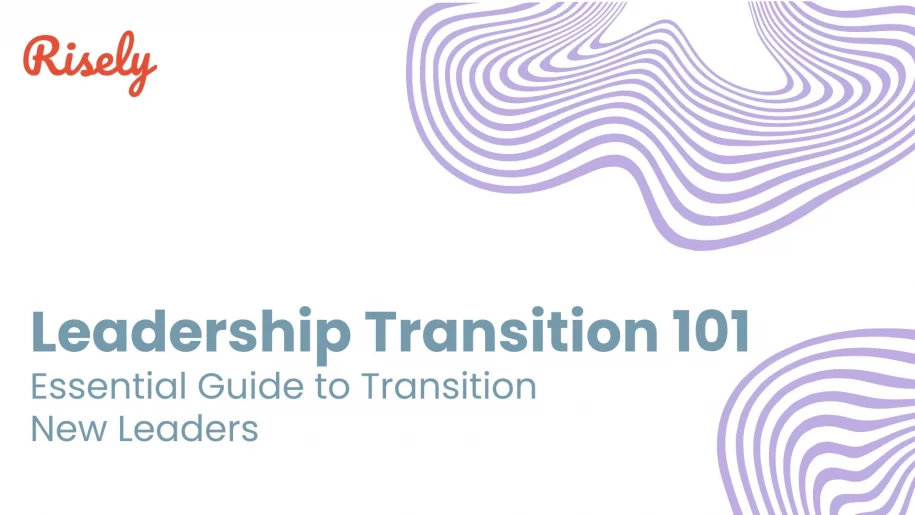Leadership Transition 101: Essential Guide to Transition New Leaders
Leadership transitions are defining moments for any organization. These shifts can significantly impact the organization’s trajectory, whether it’s a planned succession, restructuring, or a sudden change. As an HR or L&D professional, you need to ensure smooth onboarding for the new leader as well as support the entire organization through the change. In this blog, we’ll explore the nuances of leadership transition, why it matters, and how HR and L&D leaders take a proactive role in navigating this change. We’ll include actionable strategies, real-world examples, and tips to create a leadership transition plan that will set up a smooth transition for all.What is Leadership Transition?
The process of transferring authority, responsibilities, and relationships from one leader to another is called Leadership Transition. A well-planned leadership transition maintains stability, boosts morale, and leads to leadership development. On the other hand, a poorly managed transition leads to confusion, reduced productivity, and even a decline in trust. As HR and L&D professionals, you’re at the center of this process. Your role is to smoothen the onboarding for the new leader and to ensure the organization successfully transitions the change.Causes of Leadership Transition
There are various reasons for leadership transitions. Knowing why a change is happening lets you prepare better and provide the right support. Some of the common causes are:- Retirement: When long-serving leaders step down, it opens the door for fresh talent to take their place.
- Promotion: Leaders moving up the organizational ladder leave leadership gaps that need filling.
- Resignation: Leaders may voluntarily leave for new opportunities, requiring the organization to find a replacement quickly.
- Termination: Sometimes, leaders are asked to leave due to performance or alignment issues.
- Expansion: Organizational growth creates new leadership roles that need to be filled by capable individuals.
- Mergers and Acquisitions: Structural changes during these processes often lead to shifts in leadership to align with new goals.
- Succession Planning: Thoughtful, planned transitions designed to groom and prepare future leaders.
What are the Phases of a Successful Leadership Transition?
Jay McDonald, a member of the Forbes Council, shared his experience of transitioning from the board of directors to the CEO position stating “the most important principles of successful leadership transition”. He believes that simply being placed in a leadership role doesn’t automatically make someone a true leader. However, when you’re brought on board to drive change, that’s when a leader is needed, not just a manager. He wrote these four phases of successfully transitioning into a leadership role:1. Learn
Start by understanding the landscape of your organization. Have an open conversation with the previous leader, if possible, to learn what worked well and what didn’t. Extend this learning by talking to your team and clients at all levels to get their perspectives. This will give you a clear picture of what’s already in place and what might need to change.2. Assess
Don’t rush in with immediate solutions—unless the situation demands urgent action. Take time to evaluate your team’s skills. Do you have the right talent to achieve your goals? If not, are there other employees who can step up into leadership roles? Also, analyze what changes might be needed in key areas like structure, technology, customer experience, or employee culture.3. Communicate
People often feel nervous about change when they don’t know what’s going on. As you start to get a clearer picture, focus on effective communication. Be transparent about the organization’s current state and how it affects them. Use team meetings, emails, or even one-on-one discussions to keep everyone informed. A simple tool, like a card listing key priorities, will help everyone stay focused.4. Act
When it’s time to make changes, be decisive and fair. If layoffs are needed, handle them respectfully and provide support to those affected. Try to bring your team back together after the layoff, if possible. For employees whose jobs are no longer relevant, try to find them new roles within the organization. Make sure everyone, including yourself, is held accountable for moving forward.What Are Common Leadership Transition Challenges and Their Solutions?
Leadership changes are tough for any organization. If you don’t manage them well, they hurt morale, lower productivity, and slow down progress. However, with the right approach, these challenges turn into opportunities for growth, creating a culture of resilience that makes future transitions smoother.Common Challenges During Leadership Transitions
- Resistance to Change
- People often fear the unknown. Concerns about job security or lack of control leads to pushback.
- This resistance creates roadblocks, slowing the transition process.
- Misalignment with Organizational Culture
- A new leader’s vision may not match the current values and practices of the organization.
- Rapid or forceful changes disrupt morale and lead to confusion.
- Loss of Continuity
- Long-term leaders leave behind legacies that may be hard to follow.
- Employees may struggle to adapt to new leadership styles, creating a sense of instability.
Solutions for a Smooth Leadership Transition
- Address Resistance with Clear Communication
- Be transparent about the reasons for the leadership change and its impact.
- Listen to your team’s concerns, acknowledge their feelings, and provide clarity on how the transition benefits them and the organization.
- Align the New Leader with Organizational Culture
- Help the incoming leader understand the company’s values and history.
- Facilitate open discussions to build shared goals and connect the new vision with the existing culture.
- Maintain Continuity and Celebrate the Past
- Recognize and honor the outgoing leader’s contributions to create a sense of closure.
- Involve employees in the transition process to foster a feeling of inclusion and trust.
- Develop a Clear Transition Plan
- Create a roadmap outlining major tasks, timelines, and responsibilities.
- Ensure the new leader receives thorough onboarding and support to hit the ground running.
- Foster Open Communication and Collaboration
- Encourage constructive feedback and open dialogue at all levels of the organization.
- Create opportunities for your team members to voice their concerns and provide input, reducing resistance and promoting teamwork.
Developing a Leadership Transition Plan Template
A leadership transition plan serves as a roadmap, guiding you through the critical process of leadership change. It breaks down essential steps, tasks, and timelines to ensure a smooth transition. However, it’s not a one-size-fits-all solution. The template should be flexible, allowing you to customize it based on the needs and circumstances of your team as well as organization. This adaptability ensures a seamless and successful transition.Essential Elements of an Effective Transition Plan
A well-designed leadership transition plan ensures clarity and alignment among everyone involved. These are the essential elements you need to incorporate:- Clear Timeline
- Outline key milestones and deadlines to keep the process organized and on track.
- Defined Roles and Responsibilities
- Clearly specify the duties of the outgoing leader, incoming leader, and key stakeholders to eliminate confusion and encourage accountability.
- Communication Strategy
- Identify who needs to be informed, the best channels for communication, and the core messages to share. This ensures transparency and keeps everyone updated.
- Feedback and Adjustment Mechanism
- Regularly gather feedback and assess the plan’s effectiveness. Be ready to make adjustments to keep everything aligned with the organization’s goals.
Tailoring Your Plan to Fit Organizational Needs
Every leadership transition is distinct, and an effective plan should take into account the organization’s specific needs. Start by assessing the scale of the transition. A CEO change that impacts the entire organization requires a more comprehensive plan than a departmental leadership change. Organizational culture also plays an important role. In a hierarchical setup, a formal and structured approach works best, while a collaborative culture benefits from open discussions and team input. Engaging your team at all levels ensures the plan addresses their concerns and builds support for the changes ahead. Customizing your plan to fit these unique needs creates a smoother path to successful leadership transition.Examples of Successful Leadership Transitions
Real-world examples of successful leadership transitions provide helpful information on how organizations manage this important time. These leadership change examples teach useful lessons, including effective leadership development strategies, possible mistakes, and the need to adapt to changing situations. When you look at cases where leadership changes worked well, you get to learn best practices and implement them effectively.Case Studies: Leadership Change Management
| Company | Transition | Key Success Factors |
| Microsoft | Steve Ballmer to Satya Nadella (2014) | Nadella’s clear vision for a cloud-focused future, along with his focus on cultural change and empowering employees, helped Microsoft thrive. |
| General Motors | Rick Wagoner to Mary Barra (2014) | Barra’s strong leadership during a tough time for the automotive industry, along with her focus on innovation and customer needs, led GM to renewed growth and success. |
Analyzing Leadership Change Announcement Examples
How you announce a change in leadership affects how people feel about it. Announcements that focus on being open, understanding, and having clear goals for the future tend to create trust and reduce problems. Looking at good instances of announcements shows us important ways to do this: Apple‘s way of announcing the change from Steve Jobs to Tim Cook is a great example. They announced it early, before Jobs passed away. This created a smooth transfer of power and showed that Cook was ready and capable. This clear and open communication made stakeholders feel safe and helped the transition go well. Similarly, when Mary Barra became the leader at General Motors, her announcement showed her long-time experience in the company. It highlighted her strong knowledge of the industry and GM’s operations. This announcement also shared Barra’s vision for the company’s future, focusing on new ideas and making customers happy. This built confidence among stakeholders and raised their hopes for her leadership. These real-world examples show how important a smooth leadership transition is for your organization to keep working effectively and without disruptions.Conclusion
In conclusion, moving into a new leadership role needs careful planning and good communication. Success comes from welcoming change, learning from what has happened before, and creating a culture where everyone is open. By knowing the steps in a transition, tackling problems early, and making a special plan for the change, you help your organization work smoothly. Leadership changes bring chances for growth and new ideas. So, take on the journey with trust and strength.Ready to take your leadership development to the next level?
Discover how Risely’s AI-driven platform can help you empower your managers, drive growth, and create lasting impact.
How to Build a Leadership Journey? ft. Thomas Ulbrich
Effective leadership doesn’t always begin with a grand vision. Sometimes, it takes root in the courage to take the first…
AI and Leadership Development: Driving Synergy for Growth
AI and Leadership Development: Driving Synergy for Growth You know the frustration all too well. Your organization invests thousands in…
How Are AI Learning Platforms Transforming Leadership Development?
As an L&D leader, you’re likely familiar with this frustrating reality: 82% of organizations consider leadership development critical(1), yet only…
5 Essential AI Skills for L&D Leaders
5 Essential AI Skills for L&D Leaders According to LinkedIn’s 2025 Workplace Learning Report(1), 71% of L&D professionals are now…
How to Create a Course with AI: A Guide for L&D Professionals
How to Create a Course with AI: A Guide for L&D Professionals According to a McKinsey survey(1), only 11% of…


